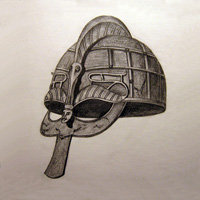
This blog is on Vikings and for Vikings. Warriors and traders from Nordic countries reached as far as North America, leaving lasting marks of their presence everywhere. In battle, Vikings feared nothing, eager to join Odin in his hall. They knew that valkyries chose who would die and become one of the einherjar in Valhalla.
If you want to write something in Norse runes, you have probably discovered that the task is rather challenging. This guide will help you through all the necessary steps. To begin, one has to look into how it works, and then figure out what kind of inscription is needed, since each type of converting into runes requires a separate approach.
How it Works
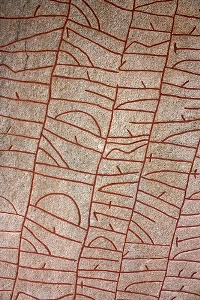 All European and many other languages use Roman letters. It may seem that taking an alphabet devised for one language (Latin in this example) and using it for another one or a whole set of different languages works all right. In fact it took about a millennium to adapt the alphabet we know today for various vernacular uses. The same applies to runes. Runic alphabets cannot and should not transcribe modern languages. We may use them to this end, but we have to invent some rules for this new and unnatural application. The nature of these rules may be illustrated by the following mental experiment: [continue reading…]
All European and many other languages use Roman letters. It may seem that taking an alphabet devised for one language (Latin in this example) and using it for another one or a whole set of different languages works all right. In fact it took about a millennium to adapt the alphabet we know today for various vernacular uses. The same applies to runes. Runic alphabets cannot and should not transcribe modern languages. We may use them to this end, but we have to invent some rules for this new and unnatural application. The nature of these rules may be illustrated by the following mental experiment: [continue reading…]
There are seven known Anglo-Saxon Age rings inscribed in runes, one of which is now disintegrated:
1. Kingmoor, Carlisle. Chance find, 1817. Now in the British Museum. Gold with niello, c. 27 mm diameter; 9th century (according to David Wilson). It has thirty runes: 27 outside the hoop and 3 inside: + æ r k r i u f l t k r i u r i þ o n g l æ s t æ p o n | t o l. Bruce Dickins noted that the group of runes ærkriu is probably akin to ærcrio in a charm for stanching blood. Therefore the rings that contain this runic group are usually thought to be amulets (cf. Bramham Moor ring below). The inscriptions are interpreted as magical gibberish. The number thirty may also be seen as a magical number, ten times three.
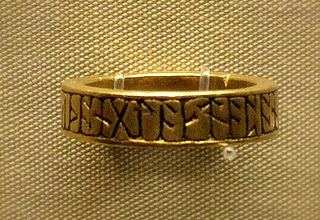 [continue reading…]
[continue reading…]
Futhorc is a system of runic writing used in Anglo-Saxon and Frisian inscriptions belonging to the 5th to 9th centuries. Already the word itself shows that Futhorc (as compared to Common Germanic Futhark) developed due to phonemic changes in the languages that it was designed to transcribe:
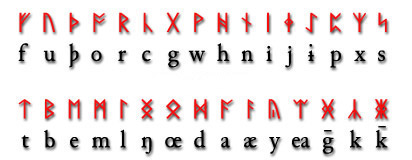
[continue reading…]
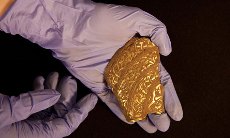 After the Staffordshire field at Hammerwich had been ploughed again last month, archeologists examined it again and discovered a new wealth of artefacts of the Anglo-Saxon period. In July 2009 the same field yielded 3,900 items, which are known worldwide as the Staffordshire Hoard. This time the scale is smaller, but the surprising fact is that many new pieces fit with parts found earlier. It means that the hoard is essentially the same. Some parts had been buried at a deeper level and were not excavated in 2009. [continue reading…]
After the Staffordshire field at Hammerwich had been ploughed again last month, archeologists examined it again and discovered a new wealth of artefacts of the Anglo-Saxon period. In July 2009 the same field yielded 3,900 items, which are known worldwide as the Staffordshire Hoard. This time the scale is smaller, but the surprising fact is that many new pieces fit with parts found earlier. It means that the hoard is essentially the same. Some parts had been buried at a deeper level and were not excavated in 2009. [continue reading…]
 Three years ago I wrote about an untitled Viking project developed by Mel Gibson. Since then many sad things happened; Mr. Gibson’s personal life has been widely discussed in the news. Many talked about his pariah status in the Hollywood. The Beaver was not successful. His other recent project, Get the Gringo, went straight to DVD. The Inception star Leonardo DiCaprio refused to work with the Viking project. The Departed screenwriter William Monahan who was supposed to write for it, as it seems, refused to do so as well.
Three years ago I wrote about an untitled Viking project developed by Mel Gibson. Since then many sad things happened; Mr. Gibson’s personal life has been widely discussed in the news. Many talked about his pariah status in the Hollywood. The Beaver was not successful. His other recent project, Get the Gringo, went straight to DVD. The Inception star Leonardo DiCaprio refused to work with the Viking project. The Departed screenwriter William Monahan who was supposed to write for it, as it seems, refused to do so as well.
However, the project is still alive. Mr. Gibson will not give up simply because this Viking project has been his dream since he was 16. At that age he first thought about being a filmmaker and it was a Viking movie that he wanted to make. He wanted to make it in Old Norse, which he studied at the time.
Earlier this year Randall Wallace who wrote for the Braveheart was reported to turn in a second draft for this new epic period movie. No horned helmets. No running around like the ’50s (Kirk Douglas and Tony Kurtis style). It will be something real and visceral. [continue reading…]
 Today I would like to share with you a few proverbs from Scandinavia. Feel free to post your own favorite Norse and Viking sayings in the comments below.
Today I would like to share with you a few proverbs from Scandinavia. Feel free to post your own favorite Norse and Viking sayings in the comments below.
Icelandic Proverbs
Neyðin kennir naktri konu að spinna.
The necessity teaches a naked woman how to spin.
Sjaldan er ein báran stök.
There seldom is a single wave. [continue reading…]
 All European and many other languages use Roman letters. It may seem that taking an alphabet devised for one language (Latin in this example) and using it for another one or a whole set of different languages works all right. In fact it took about a millennium to adapt the alphabet we know today for various vernacular uses. The same applies to runes. Runic alphabets cannot and should not transcribe modern languages. We may use them to this end, but we have to invent some rules for this new and unnatural application. The nature of these rules may be illustrated by the following mental experiment: [continue reading…]
All European and many other languages use Roman letters. It may seem that taking an alphabet devised for one language (Latin in this example) and using it for another one or a whole set of different languages works all right. In fact it took about a millennium to adapt the alphabet we know today for various vernacular uses. The same applies to runes. Runic alphabets cannot and should not transcribe modern languages. We may use them to this end, but we have to invent some rules for this new and unnatural application. The nature of these rules may be illustrated by the following mental experiment: [continue reading…]



 After the Staffordshire field at Hammerwich had been ploughed again last month, archeologists examined it again and discovered a new wealth of artefacts of the Anglo-Saxon period. In July 2009 the same field yielded 3,900 items, which are known worldwide as the Staffordshire Hoard. This time the scale is smaller, but the surprising fact is that many new pieces fit with parts found earlier. It means that the hoard is essentially the same. Some parts had been buried at a deeper level and were not excavated in 2009.
After the Staffordshire field at Hammerwich had been ploughed again last month, archeologists examined it again and discovered a new wealth of artefacts of the Anglo-Saxon period. In July 2009 the same field yielded 3,900 items, which are known worldwide as the Staffordshire Hoard. This time the scale is smaller, but the surprising fact is that many new pieces fit with parts found earlier. It means that the hoard is essentially the same. Some parts had been buried at a deeper level and were not excavated in 2009.  Three years ago I wrote about an untitled
Three years ago I wrote about an untitled  Today I would like to share with you a few proverbs from Scandinavia. Feel free to post your own favorite Norse and Viking sayings in the comments below.
Today I would like to share with you a few proverbs from Scandinavia. Feel free to post your own favorite Norse and Viking sayings in the comments below.